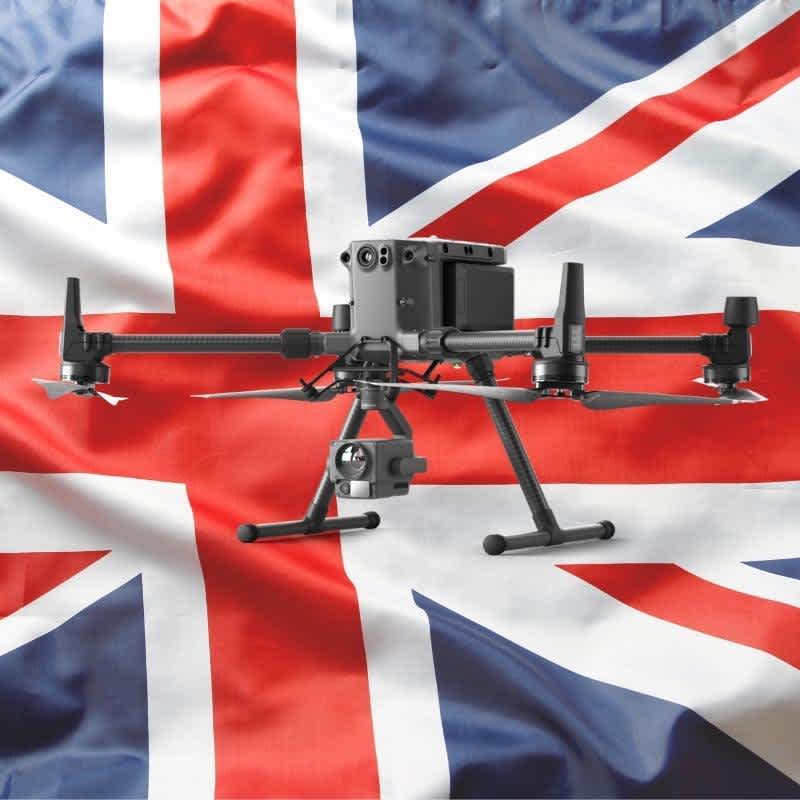
Updated on • 9 Dec 2024
UK Drone Laws 2024: Where can I fly?
UK drone laws explained. In-depth guide to where you can fly, A2 CofC and GVC drone training, FPV drone laws, UK drone registration, Operating Safety Cases (OSC), drone privacy and best drone apps.
So, you’ve bought a drone, or you’re thinking of purchasing one.
Among the key considerations is how to fly legally and safely in the UK.
This guide to UK drone regulations and registration will help you understand if you need drone training or not. heliguy™ - which has trained 7,000+ candidates - has a team of in-house instructors and offers a progressive training pathway. Online training and in-person training is available.
UK Drone Laws: At A Glance
Here are some key points to know, before reading about the rules in more depth.
Three operational categories: Open (geared to hobbyists/some commercial users); Specific (mainly enterprise drone pilots); Certified (very high-risk operations).
Open Category divided into subcategories: A1 (fly over people); A2 (fly close to people); A3 (fly far from people). Certain drones can fly under the rules of certain subcategories.
UK CAA has said that European Union (EU) class marks on drones will not be recognised in the UK from December 23, 2022.
A Transitional Period has been extended to 1 January 2026. This allows current drones - with no class marking or a class marking which is not recognised in the UK - to continue to be flown in line with more relaxed rules, as part of the drone regulations.
An A2 CofC - which can be completed with heliguy™ - is required to operate drones weighing up to 2kg in the A2 subcategory or drones weighing between 250g and 500g in the A1 subcategory.
Operations which can't be performed in the Open Category can be performed in the Specific Category. An Operational Authorisation - replacing the PfCO - is needed from the CAA.
A General Visual Line of Sight Certificate (GVC) - which can be obtained with heliguy™ - is needed to apply for an Operational Authorisation.
Valid PfCOs (as of December 31, 2020) will be brought into line with the Operational Authorisation.
There is now no differentiation between 'leisure' and 'commercial' drone flights.
In most cases, UK drone registration is required.
This blog also details what UK drone operators need to do to fly in Europe.
UK Drone Laws: Where Can I Fly?
Where you can fly is dictated by the type of drone you have and the level of risk involved in the flight.
Therefore, drone flights will fall into one of three categories. These are:
Open: Presents low risk to third parties. An authorisation from the CAA is not required.
Specific: More complex operations or aspects of the operation fall outside the boundaries of the Open Category. Authorisation is required from the CAA.
Certified: Very complex operations, presenting an equivalent risk to that of manned aviation. UK regulations relating to the Certified Category are still being developed and are not yet published. Until unique UAS regulations are available, the principles set out in the relevant manned aviation regulations for airworthiness, operations, and licensing will be used as the basis for regulating the Certified Category.
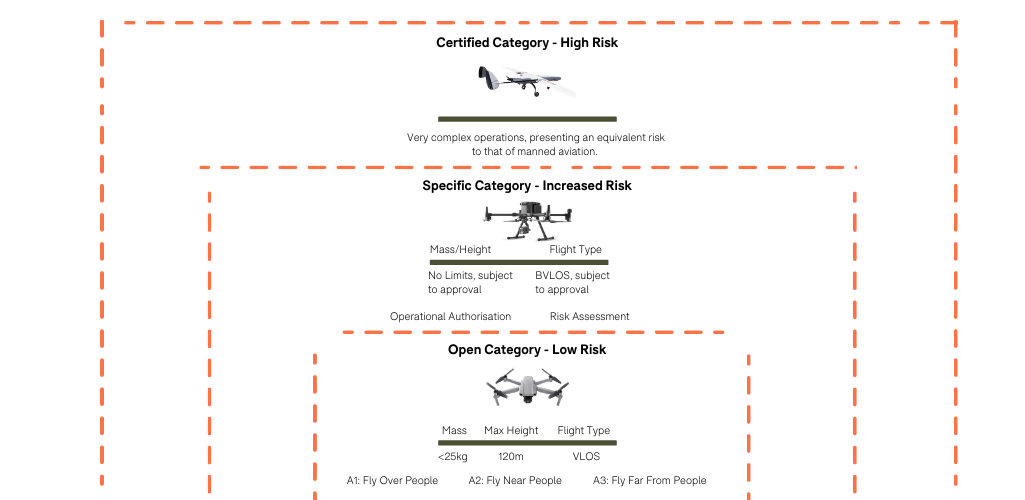
The Open Category
Pilots flying by the rules of the Open Category will tend to be hobbyist/recreational flyers, as well as certain commercial pilots.
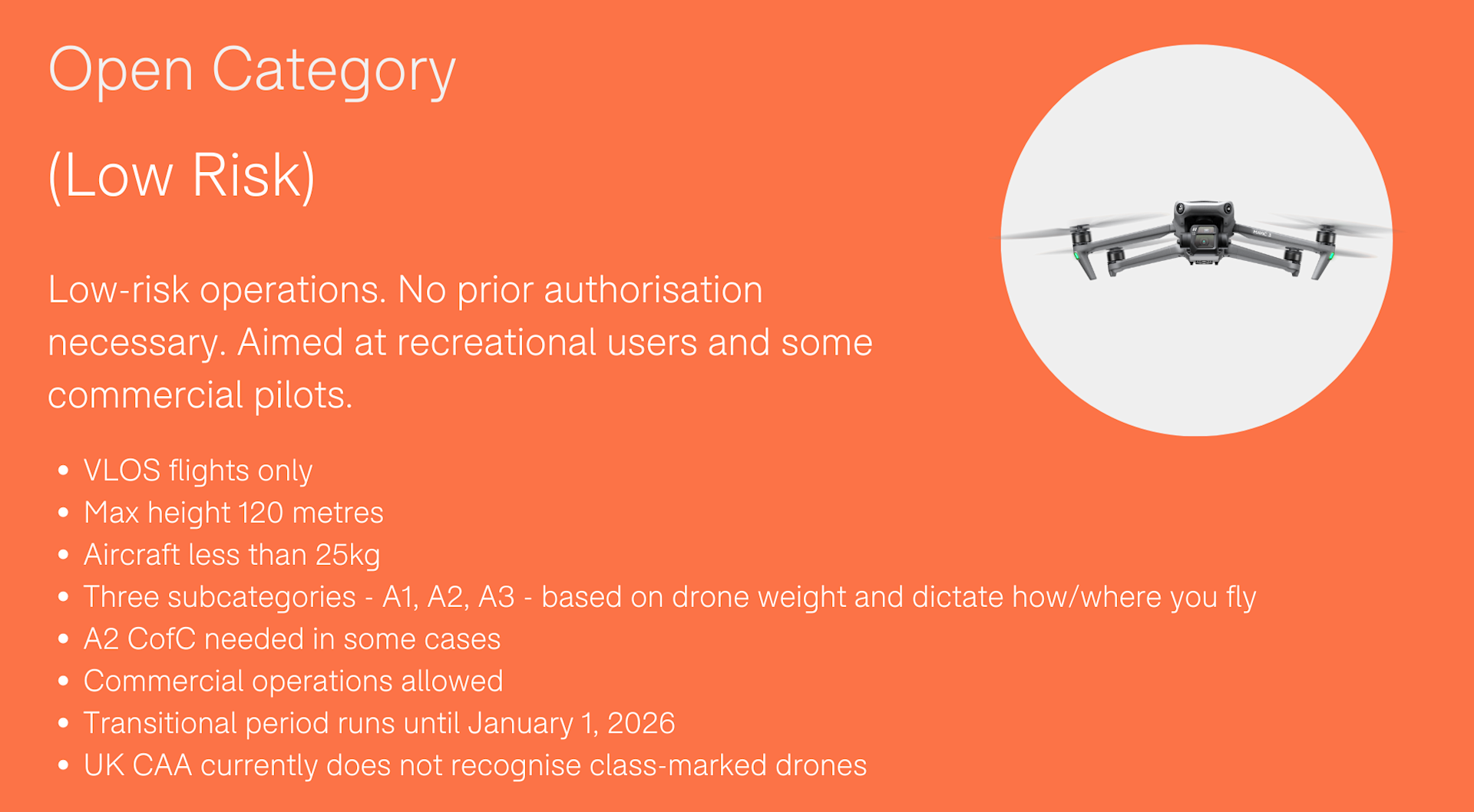
There are a number of basic requirements that all Open Category pilots must adhere to:
The aircraft's maximum take-off mass must be less than 25kg;
Keep the drone within Visual Line of Sight (VLOS);
Do not fly higher than 400 ft (120 metres) from the earth's surface.
Operators needing to fly outside one or more of these conditions will be required to seek permission to fly in the Specific Category.
However, the 400ft rule can be exceeded when a drone is required to overfly obstacles taller than 105m, provided that:
The obstacle is overflown by a maximum of 15m;
You have permission from whoever is in charge of the obstacle;
You must stay within 50m horizontally of the obstacle.
The Open Category - Subcategories A1 - A3
The Open Category is further divided into three subcategories, stipulating where, what and how you can fly:
A1 Subcategory - Fly Over People
This category is for drones which pose the least risk, due to their weight and other factors.
Drones such as the DJI Mini Series (including the DJI Mini 4 Pro, Mini 3 Pro, and Mini 3), and the DJI Neo, can be operated in this subcategory.
Operating Area
No flights within restricted airspace (Restricted Areas, Danger Areas, FRZs) without relevant permission.
Flight permitted within residential, commercial, industrial and recreational areas.
Separation from uninvolved people
Drones with sub-250g flying weight (such as DJI Mini Series and DJI Neo): No flight over crowds.
A1 Transitional drones (between 250g and 500g, such as DJI Avata Series; DJI Mavic Air; and DJI Spark): No intentional flight over uninvolved persons.
Subcategory | Operating Area | Drone Class | Mass/KE/Speed | Registration (UAS Operator) | Competency (Remote Pilot) |
A1 | Fly over uninvolved people, but not over crowds. | Privately built, or placed on the market before 01 Jan 2026. | <250g flying weight | Only if 'camera' equipped (but not toys) | • Read user manual • Online training and exam (DMARES - drone registration test) in some instances. |
A1 | No intentional flight over uninvolved persons | A1 Transitional - Not after 01 Jan 2026 | <500g flying weight | Yes | • Read user manual • Online training and exam (DMARES - drone registration test) • A2 CofC theoretical test |
A2 Subcategory - Fly Near To People
The A2 subcategory can be utilised by A2 Transitional drones - ie drones which are currently on the market but not class-marked (or don't have a class mark recognised by the UK CAA) - which weigh up to 2kg. In this category, they can fly up to 50m horizontally from people.
Drones such as the Mavic 3 Series, including Mavic 3 Pro; Mavic 3 Enterprise Series; DJI Air 3S and DJI Air 3; DJI Air 2S and Air 2; DJI FPV; DJI Phantom 4 Series, and DJI Mavic 2 Series can be flown in this subcategory.
However, all pilots must have an A2 CofC to fly in the A2 subcategory.
Operating Area
No flights within restricted airspace (Restricted Areas, Danger Areas, FRZs) without relevant permission.
Flights allowed within residential, commercial, industrial and recreational areas.
Separation from uninvolved people
A2 Transitional aircraft (2kg max, such as DJI Mavic 3 and Mavic 3 Pro Series; DJI Avata Series; DJI FPV; DJI Mavic 2 Pro/Zoom, DJI Air 3S and Air 3; DJI Mavic Air 2 and Air 2S, and Phantom 4 Series): No closer than 50m horizontally from uninvolved people.
Subcategory | Operating Area | Drone Class | Mass/KE/Speed | Registration (UAS Operator) | Competency (Remote Pilot) |
A2 | No closer than 50m horizontally from uninvolved persons | A2 Transitional - Not after 01 Jan 2026 | <2kg flying weight | Yes | • User manual • Online training and online (foundation) test (DMARES - drone registration test) • Self-practical training • A2 CofC theoretical test |
A3 Subcategory - Fly Far From People
This subcategory involves flights far away from people.
It is for larger aircraft and for pilots who have an A1 Transitional or A2 aircraft, but have not obtained an A2 CofC.
Drones such as the DJI M350 and M300 RTK; M30 Series; DJI M200 Series, and DJI Inspire Series, would need to be flown in this subcategory. Although, in most cases, pilots with these drones would likely fly in the Specific Category with an Operational Authorisation.
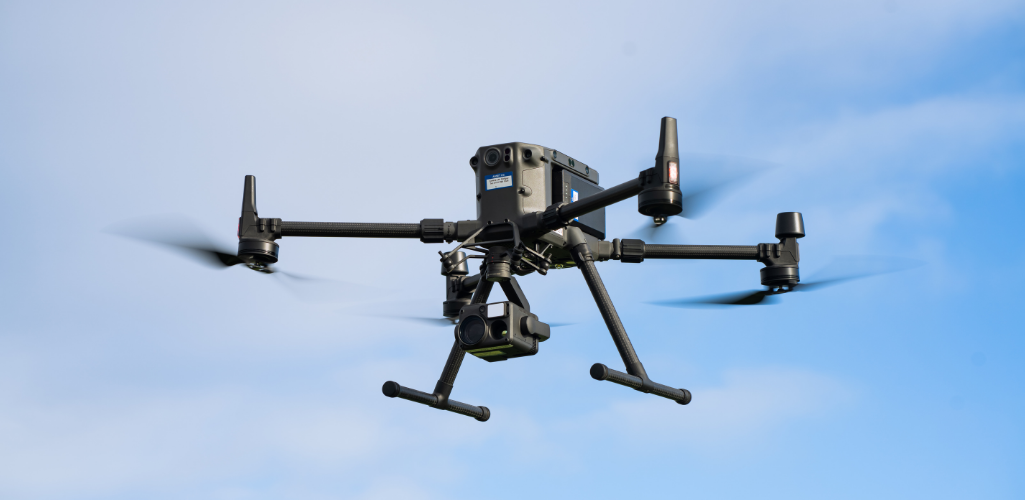
Operating Area
No flights within 150m horizontally of residential, commercial, industrial or recreational areas.
No flights within restricted airspace (Restricted Areas, Danger Areas, FRZs) without relevant permission.
Separation from uninvolved people
No uninvolved persons to be present within the area of the flight.
No closer than 50m horizontally at any time.
Employ 1:1 rule when reacting to unexpected issues.
Subcategory | Operating Area | Drone Class | Mass/KE/Speed | Registration (UAS Operator) | Competency (Remote Pilot) |
A3 | • No uninvolved people present within the area of flight. Maintain 50m separation from any uninvolved people. • No flight within 150m horizontally of residential, commercial, industrial or recreational areas. | Privately built or placed on the market before 01 Jan 2026. | <25kg flying weight | Yes | • User manual • Online training and Online (foundation) test (DMARES - drone registration test) |
Drone Classes And The Transitional Period
Under the new drone laws, a class classification system was introduced - giving drones a class marking (C0-C4), based on certain criteria, such as weight, speed, and safety features.
This class identification would determine which subcategory of the Open Category the drone could be flown in.
Class-marked drones do exist - such as the DJI Mavic 3 Classic, while the Mavic 3 and Mavic 3 Cine have been retrospectively class-marked.
However, these class markings are for the EU, and are not recognised in the UK.
The UK CAA has said that from December 23, 2022, drones with an EU class mark will not be recognised in the UK, meaning they will need to be flown under Transitional provisions within the Open Category.
As part of this, the Transitional period has been extended. It was due to finish at the end of 2022, but it has been extended to January 1, 2026.
It means that current drones with no class mark (or a class mark not recognised in the UK) can be operated in accordance with Transitional provisions. The extension means that current drones can be used in this way for longer.
The table below shows which subcategory each DJI drone currently falls in to. This is based on none of these drones having class markings (including those whose EU class markings are not recognised by the UK CAA).
Flying Weight | DJI Drone Type | Maximum Flight Height | Flights Over People | A2 CofC Required? | |
A1 | < 250g | DJI Mini Series DJI Neo | 120m | Flights over uninvolved people allowed, but not over crowds | No |
A1 Transitional | 250g - 500g | DJI Mavic Air DJI Spark DJI Avata 2 and Avata 1 | 120m | No intentional flights over uninvolved people | Yes |
A2 Transitional | 500g - 2kg | Mavic 3 Series Mavic 3 Enterprise Series DJI FPV DJI Air 3S & DJI Air 3 Mavic Air 2 & Air 2S DJI Mavic Pro Mavic 2 Series DJI Phantom Range | 120m | No closer than 50m horizontally from uninvolved people | Yes |
A3 Transitional | <25kg | Inspire Series Matrice Series M30 Series. A1 Transitional & A2 Transitional drones where pilots do not hold an A2 CofC. | 120m | No uninvolved people present within the area of flight. Maintain 50m separation from any uninvolved people. No flight within 150m horizontally of residential, commercial, industrial, or recreational areas. | No |
From January 1, 2026, DJI drones without drone class identification labels can only be operated in the Open Limited Category A1 (if they weigh below 250g) or A3 (between 250g and 25kg), and in the Specific Category with an Operational Authorisation.
Drone Class Markings Vs UKCA Mark
Please note that some drones have a UKCA mark. This is a post-Brexit UK Conformity Assessed mark, which is now required for goods and products being placed on the market in Great Britain and currently covers most goods which previously required the CE marking, known as ‘new approach’ goods.
Therefore, this mark is different to the C0-C4 drone class marks which relate to which subcategory a drone can be flown.
Open Category - What Training Is Required?
Pilots wanting to operate in the A2 subcategory, as well as the A1 subcategory with an A1 Transitional drone, need to obtain an A2 CofC, known as an A2 Certificate of Competency.
This course can be completed with Heliguy, through our online training platform, followed by a theory test, which can be sat remotely.
Candidates do not need to complete an Operations Manual or pass a Practical Flight Test, but a period of practical flight training (either with Heliguy or under self-monitored circumstances) is required.
An A2 CofC is valid for five years.
You can find out more about the A2 CofC here.
The information below highlights what level of competency is required for each Open Category subcategory.
A1 Subcategory - Training
Drones less than 250g flying weight: Read the drone's user manual. DMARES (Drone and Model Aircraft Registration and Education Service) online learning and test to get a Flyer ID is recommended to promote safe flying.
A1 Transitional: Complete the DMARES (Drone and Model Aircraft Registration and Education Service) online learning and obtain a Flyer ID by sitting the free DMARES exam; and obtain an A2 CofC.
A2 Subcategory - Training
Complete the DMARES online learning and obtain a Flyer ID; and obtain an A2 CofC.
A3 Subcategory - Training
Complete the DMARES (Drone and Model Aircraft Registration and Education Service) online learning and obtain a Flyer ID by sitting the free DMARES exam.
Open Category - How Old Can I Be To Fly?
At the start of February 2021, the Department for Transport removed the minimum age requirement for remote pilots, meaning that children below the age of 14 can operate as remote pilots in the Open Category.
Rules For Members Of Flying Associations
The CAA has issued an Authorisation (Model Aircraft Article 16 Authorisation) to flying associations to enable different and more flexible operation requirements for operators flying drones up to 25kg.
This applies to members of the British Model Flying Association (BMFA), Scottish Aeromodellers Association (SAA), Large Model Association (LMA), and FPV UK.
Aircraft with a maximum take-off mass (the weight of the aircraft when it becomes airborne) of more than 25kg will be subject to a separate Authorisation held by the Large Model Association.
While the Open Category rules can be used by anyone in the UK, these requirements will not apply to Association members flying in accordance with the terms and conditions of the Article 16 Authorisation.
Click to read the Authorisation in full, or use the drop-down boxes below for an at-a-glance guide.
Line Of Sight
You must operate your aircraft within visual line of sight (VLOS).
If flying using first-person view, you must have a competent observer next to you who maintains VLOS with the aircraft. Special rules apply to FPV drone racing within a 'sterile area'.
Free flight aircraft must not be deliberately flown beyond VLOS.
Where Can I Fly?
Essentially, wherever you fly now.
The Authorisation is valid throughout the UK at:
Any established model flying club site. Clubs operating in a ‘built up area’ (area substantially used for industrial, recreational, commercial or residential purposes) must conduct a risk assessment and have suitable mitigations in place within their Field Safety Rules.
Any other suitable site which is not a ‘built-up area’.
Within a ‘built up area’ if the flying site is within an area which is only used substantially for recreational purposes (for example playing fields or sports pitches) and a risk assessment has been carried out.
Flying Height And Separation Distances
The Authorisation permits Association members to fly above 400ft, as long as:
The model aircraft is not a multi-rotor.
The model aircraft is not automated.
The model aircraft in not operating with the Flight Restriction Zone of an aerodrome, other than with the written permission/agreement with the aerodrome.
The model aircraft remains within visual line of sight of the remote pilot.
The model aircraft has a maximum take-off mass below 7.5kg.
Model gliders with a maximum take-off mass below 14kg may be flown at a height of 400ft above the remote pilot (which if flying from a slope permits operation at heights exceeding 400ft from the surface beneath the glider).
When operating at heights which may exceed 400ft, keep a good look out for manned aircraft. If a manned aircraft appears in the vicinity, bring the model aircraft under 400ft as quickly as is safely practicable.
Separation distances from uninvolved people
For aircraft under 7.5kg, do not fly within:
30m of uninvolved people;
30m horizontal distance from an assembly of people.
The distance can be reduced to 15m for take-off and landing in some circumstances.
For aircraft over 7.5kg, do not fly within:
30m of uninvolved people;
50m horizontal distance from an assembly of people.
Flying within 'built-up areas' is only permitted subject to the conditions outlined in the guidance.
Can I Fly For Commercial Gain?
No.
The purpose of the flight must be sport, recreation, education or demonstration.
The terms of the Authorisation do not cover any type of commercial operation.
Registration/Competency
Any remote pilot operating in accordance with the Article 16 Authorisation must demonstrate a suitable level of pilot competency, by either a or b, as outlined below:
a) Passing one of the following online tests
CAA online DMARES test
BMFA online test
LMA Theoretical Proficiency online test
FPV UK certificate of competency: Drone law ('A' Certificate) online test
b) Having passed the test (prior to December 31, 2020) for:
BMFA Achievement Certificate
SAA Bronze Certificate
LMA Basic Proficiency of Full Proficiency Test
FPV UK Certificate of Competency: Drone Law Test
It is also a legal requirement for most model flyers to register as an Operator with the CAA (if 18 or over).
The exception is when:
The aircraft weighs 250g or less and is not fitted with a camera;
The aircraft is a control line or round-the-pole (tethered) aircraft that weighs 1Kg or less;
The aircraft is a 'toy' as defined in the EU Regulations.
The Operator ID number must be clearly displayed on the aircraft or within a compartment that can be easily accessed without the use of a tool.
Age Requirements
A CAA Operator ID can only be obtained by those aged 18 and over.
However, pilots can be under 18.
The minimum age for a remote pilot to fly unsupervised within the full terms of the Article 16 Authorisation is 10.
There is no minimum age for a remote pilot operating under the direct supervision of another remote pilot (age 14 or over) provided both have the required evidence of competency. In addition, there must be an adult Operator (when an Operator is mandatory).
Aircraft Less Than 250g
Model aircraft and drones below 250g can be operated under this special authorisation, as long as the rules are followed.
Or, operate within the requirements of the Open Category.
Specific Category
As mentioned previously, the Specific Category covers operations that present a greater risk than that of the Open category, or where one or more elements of the operation fall outside the boundaries of the Open category.
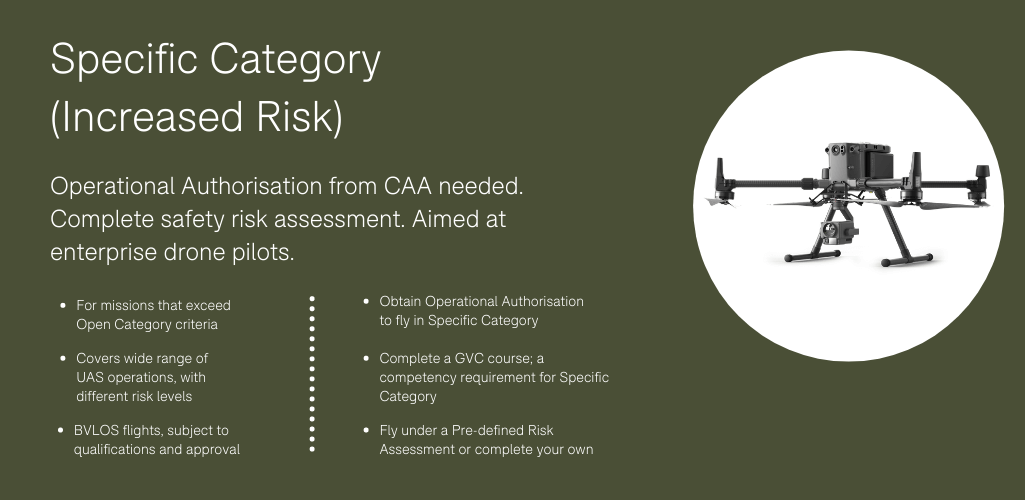
In simple terms, the Specific Category is geared towards enterprise drone pilots.
The key element of the Specific Category is that the UAS operator is required to hold an Operational Authorisation, which has been issued by the CAA.
An Operational Authorisation has replaced the PfCO.
The Operational Authorisation sets out the privileges that are afforded and the limitations that must be followed when conducting the operation.
To obtain an Operational Authorisation, the operator must conduct a risk assessment of the proposed operation and submit this as part of the application.
Pre-Defined Risk Assessments
Alternatively, operators can use a PDRA (Pre-defined Risk Assessment).
This is a shortened set of prescriptive conditions - conducted by the CAA - that must be complied with by a UAS operator in order to conduct a predetermined type of operation.
This type of approach applies to operations that will most likely be conducted by a large number of operators (i.e. it is a pre-defined scenario), but the safety mitigations are relatively simple.
UKPDRA01
This PDRA is for operations within 150 metres of any residential, commercial, industrial or recreational area for a drone with a maximum take-off mass of less than 25kg.
It is designed to enable VLOS operations in the areas that are likely to be more ‘congested’ than the areas where subcategory A3 operations are permitted.
It provides the same operating privileges to those previously available under a PfCO.
UKPDRA01 enables the following operations:
VLOS only, maximum 500 metres horizontally from remote pilot; use of a UA observer situated next to the remote pilot, is permitted;
Maximum height not to exceed 400 feet above the surface;
Flight permitted within 150 metres of any residential, commercial, industrial or recreational area;
No flight within 50 metres of any uninvolved person, except that during take-off and landing this distance may be reduced to 30 metres;
No flight within FRZs unless permitted by the relevant aerodrome;
No flight within 50 metres horizontally of assemblies of people.
All remote pilots involved in the operation must be in possession of valid PfCO or GVC qualifications, and a valid Operational Authorisation.
UKPDRA02
This PDRA is intended for flights for Research and Development Testing of drones with a maximum take-off mass of between 25kg and 150kg.
It enables short-term initial research and development flights to be conducted, within a sterile area away from people and property.
This PDRA allows drone manufacturers and developers to conduct initial proof of concept flight tests without the need to produce a full risk assessment.
UKPDRA02 enables the following operations:
Drone operations for the purpose of research and development;
Flights must be conducted within a sterile area free of any uninvolved persons;
No flight within 50 metres horizontally from any uninvolved persons;
Maximum height not to exceed 400 feet above the surface;
Flights must be conducted at least 150 metres horizontally from any Residential, Commercial, Industrial or Recreational Area;
Daytime operations ONLY and within VLOS;
Maximum horizontal distance from the remote pilot must not exceed 250 metres, unless a lesser control link radio range has been specified by the manufacturer;
Direct unaided visual contact with the said aircraft must be maintained, sufficient to monitor its flight path for the purposes of avoiding collisions;
Maximum speed: 35 knots in any direction where the MTOM is less than 75kg; 25 knots in any direction where the MTOM is between 75kg and 150kg; Where the speed cannot be measured, the Unmanned Aircraft is not to be operated at a speed that is greater than a fast walking pace;
Articles may be picked up by, raised to, and dropped or lowered from the UA provided that the activity is confined to a sterile area defined for this purpose, and is conducted in a way that will not endanger persons or property;
Operations must not be conducted in controlled airspace (Class D and E), except with the permission of the appropriate Air Traffic Control Unit;
Operations must not be conducted within Aerodrome Traffic Zones (ATZ), Restricted Areas or Danger Areas unless the requirements for access to such airspace has been complied with;
Carriage of persons is not permitted.
UAS Operators must produce an operations manual which details how the flights will be conducted, and all remote pilots involved in the operation must be in possession of a valid GVC.
Operating Safety Case
Some missions will require an Operating Safety Case (OSC), which enables operators to fly outside the confines of a Standard Permission, like an Operational Authorisation, in the Specific Category.
An OSC is required for numerous operational procedures, such as:
Flying less than 50m from uninvolved people.
Flying less than 50m from uninvolved buildings / property.
Flying less than 50m horizontally of crowds of people.
Flying more than 400ft in altitude.
Conducting EVLOS missions with multiple pilots.
Flying beyond visual line of site (BVLOS)
An OSC is a complex, three-volume operations manual that is submitted to the CAA.
Heliguy has launched an OSC Consultancy to help operators complete an OSC application. To find out more, click here.
Specific Category - What Training Is Required?
The GVC (General Visual Line of Sight Certificate) is a remote pilot competency certificate which has been introduced as a one stop qualification that satisfies the remote pilot competency requirements for VLOS operations within the Specific Category.
The GVC satisfies the competency requirements of any published PDRA that involves VLOS flight.
The GVC can be completed with Heliguy, by completing an online theory course and passing an exam.
As well as the theory test, candidates also need to complete an Operations Manual and pass a Practical Flight Assessment.
The GVC is valid for five years.
You can learn more about the GVC here.
What If I Have A Valid PfCO?
Valid PfCOs will be amended to bring them into line with the Operational Authorisation.
This means that a valid PfCO did not become null and void on December 31, 2020.
Rather, the terms of the operating conditions will be amended to align with the Operational Authorisation. This will ensure that all relevant UAS operators hold the same privileges.
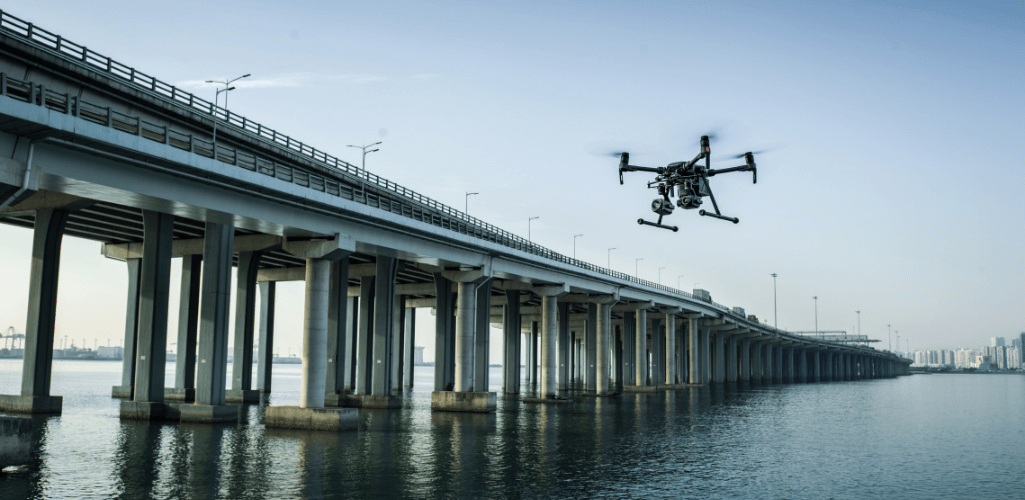
It is applicable until the expiry date of a remote pilot’s PfCO/standard permission.
Once a renewal application is submitted, the applicant will receive an Operational Authorisation and individuals with NQE qualifications may continue to renew that Operational Authorisation until January 1, 2024, before which, they’ll be required to undertake the PfCO to GVC Conversion course.
Operators with a current and valid PfCO must ensure they have a valid Flyer ID, obtained as part of the CAA’s drone registration service.
You can read more about it, here.
Specific Category - How Old Can I Be To Fly?
At the start of February 2021, the Department for Transport removed the minimum age requirement for remote pilots, meaning that children below the age of 14 can operate as remote pilots in the Specific Category.
Drone Laws - Is FPV Flying Legal In The UK?
FPV drone flying and the use of goggles is legal in the UK.
FPV flights are permitted within the Open and Specific categories, subject to certain criteria being met.
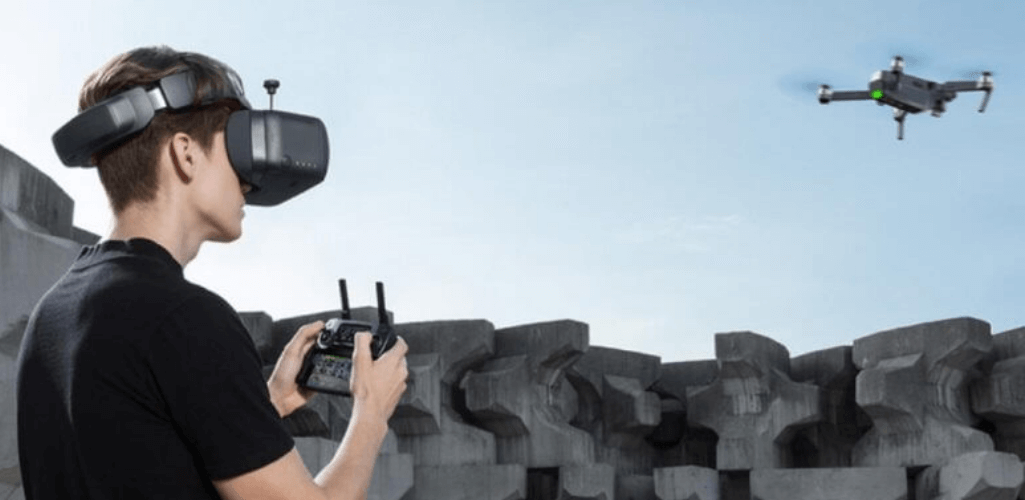
A key aspect is that FPV pilots can fly without keeping direct eye contact with the drone – provided they are accompanied by a unmanned aircraft observer who keeps direct visual contact with the drone.
The UA observer must be located alongside the pilot so they can immediately communicate with the pilot.
Association members of drone and model aircraft clubs are afforded greater flexibilities for FPV flights and drone racing - courtesy of the Article 16 Operational Authorisation.
Click to find out more about FPV Drone Laws In The UK.
How About Follow Me Mode?
Follow-me mode is legal.
It can be used for flights, up to a maximum distance of 50m from the remote pilot, in the Open Category.
UK Drone Laws: What About Flying Near To Vehicles, Vessels, and Structures?
It is true that the regulations are focused on the safety of uninvolved people and there are no specific minimum distances set down for separation from ‘vehicles, vessels and structures’.
But, this does not imply a complete ‘free for all’ as vehicles, vessels and structures will in many cases still have persons inside them which need to be protected.
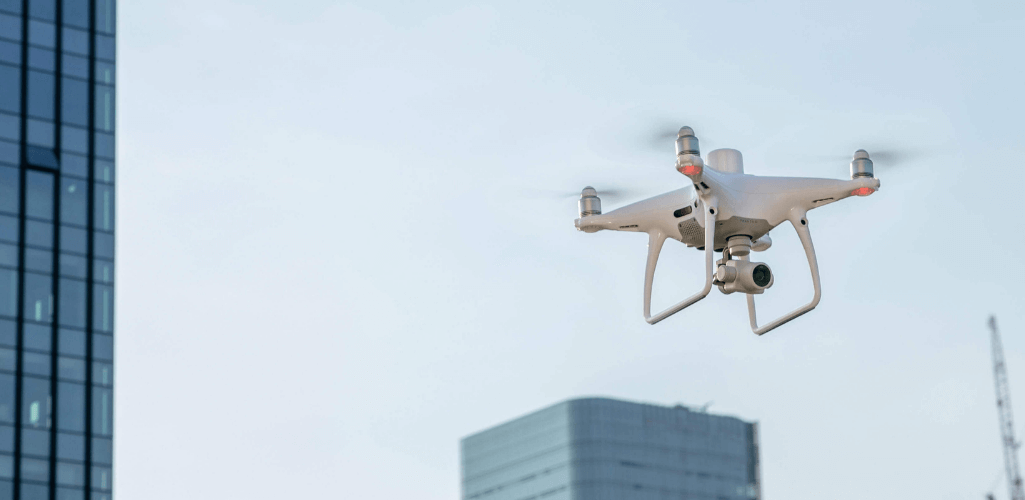
There are two points to take note of:
The current ‘endangerment’ regulation in the Air Navigation Order (article 241), still applies, and so it is an offence to ‘endanger’ such property with an unmanned aircraft.
The prescribed separation distances from uninvolved persons still apply to persons that are occupants of any vehicle, vessel or structure. So, you still have to apply the relevant limitations for separating from persons, unless you can be certain that they are unoccupied or, in the case of structures, you can be certain that the occupants will be protected because of how the structure has been manufactured.
Of course, the overall security and privacy situation must also be considered, as there will be a number of buildings where it would be inadvisable, from a security or privacy standpoint, to be flying close to without first obtaining permission to do so.
UK Drone Registration
It is important to know that you must register with the CAA before flying most drones outdoors in the UK.
There are two requirements and you may need to meet both:
If you’ll fly, you must pass the DMARES theory test to get a flyer ID;
If you’re responsible for a drone or model aircraft, you must register for an Operator ID and then label the drones with this ID.
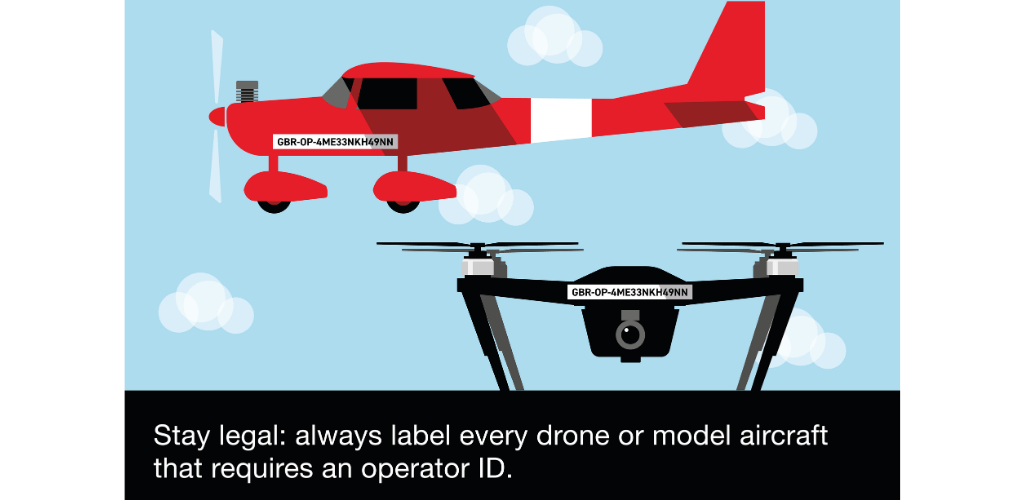
It is against the law to fly a drone or model aircraft without having the required IDs.
You can register here.
Drone Registration - Who Needs To Register?
In most cases, registration is required.
But, you do not need to register if you will only fly or use the following types of drone or model aircraft:
Below 250g - toy
Below 250g - not a toy - no camera
It is important though that pilots of these drones follow the DroneCode.
This table shows what is required, depending on your aircraft's weight, and other factors.
Flyer ID | Operator ID | |
Below 250g - Toy | No | No |
Below 250g - Not a toy - no camera | No | No |
Below 250g - not a toy - with camera | No | Yes |
250g and above | Yes | Yes |
For clarification, the above table shows that pilots of the DJI Mini series (below 250g, not a toy, with camera) would need an Operator ID, but not a Flyer ID.
However, the CAA has said that, where the law doesn't require pilots to obtain a Flyer ID, it is still strongly encouraged - as it is free and will provide an overview of the rules to promote safe and legal flying.
Click to find out more about the drone registration test.
Drone Registration - How Much Does It Cost?
The cost depends on whether you are obtaining a Flyer ID or an Operator ID.
Cost | Valid For | |
Flyer ID | Free | 5 Years |
Operator ID | £11.13 annually | 1 Year |
Drone Registration - How Old Do I Have To Be?
Children under 13 must pass the test to get a Flyer ID. Children under 13 must have their parent or guardian with them when they take the test to get their Flyer ID.
Meanwhile, you must be 18 or over to register for an Operator ID. You can use the same operator ID for all your drones and model aircraft.
If you are under 18, then a parent or guardian is required to get the Operator ID.
At the start of February 2021, the Department for Transport (DfT) removed the minimum age requirement for remote pilots, meaning that children below the age of 14 can operate as remote pilots in both the Open and Specific Categories.
How To Label Your Drone
You must label your Operator ID on every drone or model aircraft you’re responsible for.
Use the same Operator ID for all your drones or model aircraft.
Always label with your Operator ID, not your Flyer ID.
Your operator ID must be:
Visible from the outside, or within a compartment that can easily be accessed without using a tool
Clear and in block capitals taller than 3mm
Secure and safe from damage
On the main body of the aircraft
UK Drone Operators Flying In Europe
So, you are a UK drone operator with an A2 CofC or GVC/Operational Authorisation, but you need to fly in Europe. Where do you stand?
Rules For UK Drone Operators Flying In EU Member States
Please note that the following information relates to flights within the EU or an EASA associate Member State (Iceland, Liechtenstein, Norway and Switzerland).
Registration
UK operators must register with the Member State they wish to fly in.
Open Category Flights
A2 Subcategory: You need to obtain a new A2 CofC in the EU Member State you wish to fly. Once you have this, the European version of the A2 CofC will be valid in all other EU Member States and EASA associate Member States. For example, if you complete an A2 CofC for operations in Germany, you can then use this for flights in France, Italy, Spain etc.
A1 and A3 Subcategories: You can fly without drone training, as is the case in the UK. Please note that flights using A1 Transitional aircraft in the A1 subcategory will require an A2 CofC, so follow the process outlined above.
Specific Category Operations
If you have completed the UK GVC and have an Operational Authorisation, your next steps depend on the specific aviation authority of the EU Member State you wish to operate in.
Some will recognise the UK GVC/Operational Authorisation. In this case, you will need to amend your Operations Manual to recognise your operation in the specific Member State, such as changing your PDRA to a Standard Scenario.
However, some aviation authorities will require you to complete a separate GVC and apply for a new Operational Authorisation for operations in that Member State.
To understand your position, check with the relevant aviation authority ahead of your operations.
Rules For UK Drone Operators Flying In Non-EU Member States
UK UAS Operators wishing to operate within any State other than one which is a member of the EU or EASA Associate Member must comply with the requirements that are set out for UAS operations within that State.
In the first instance, operators should consult the guidance documentation that has been prepared by the relevant NAA.
Best Drone Apps And Websites To Keep You Flying Safely And Legally
There are numerous apps and websites available to help you fly safely and legally and check UK airspace.
Some of the key ones are:
Drone Assist: Drone safety app from NATS, with an interactive map of airspace used by commercial air traffic.
NATS Drone Website: Provides a wealth of information about flying your drone. Click here for more details.
Flight Planning Map: Up to date NOTAMS (notice to airmen) plotted on a map. Click here for more details.
AirMap: Real-time feedback of airspace rules and conditions pertaining to your flight specifications. Click here for more details.
Coverdrone FlySafe: Coverdrone FlySafe is a free app designed to help drone pilots plan and conduct their drone flights quicker and safer than before. Click here for more details.
UAV Forecast: As a drone pilot, one of the key considerations is the weather. UAV Forecast is an incredibly useful source of information, telling you everything you need to know about whether or not it is safe to fly. Click here for more details.
Windy: Windy is another app which supplies drone pilots with useful information about weather conditions. Click here for more details.
Tesla Magnetic Field Recorder: The Tesla Magnetic Field Recorder helps you to detect and record magnetic fields. The compass in your drone uses magnetic fields, and if there’s magnetic activity at or near your location, you could have issues and your drone operation could be threatened. Click here for more details.
To find out more about some of these apps, and others in the industry, read our in-depth blog by clicking here.
UK Drone Laws: Other Things You Need To Know
There are other factors you need to be aware of before you fly your drone. These include:
Airports: Most airports and airfields have a flight restriction zone (FRZ). Never fly in this zone unless you have permission from the airport. The zone is in place to avoid any collisions with aircraft at or near the airport.
Restricted airspace: This includes areas around prisons, military bases, royal palaces, government sites and more.
Events: Flying may be temporarily banned in specific areas during some events, such as airshows or festivals. This is to keep everyone safe.
Emergency incidents: Temporary restrictions may be established at very short notice due to emergency incidents, such as road traffic accidents, fires and floods.
Byelaws: Byelaws may restrict when and where you can fly. Look out for local signs for information and contact details where you can find out more. Byelaws are unlikely to be shown on apps or drone websites.
Structures in the area: Check for any structures, such as cranes, masts and wires. Do not fly if there are structures in the area that will mean it’s not safe or legal.
Animals: Do not fly where you’ll disturb animals.
Report any dangerous incidents or near misses: If something dangerous happens while you’re flying your drone or model aircraft, you must report the incident to the Civil Aviation Authority. Click here.
Insurance: Insurance is optional if you’re flying for recreation. However, you should remember that you’re responsible for your actions, which means you could be held personally liable for any injury or damage you cause while you’re flying. If your flight is for any reason other than recreation, you do need insurance. EC785/2004 compliant insurance is still required for commercial operations in both the Open and Specific categories.
Make sure you are fit to fly: Do not fly under the influence of alcohol or drugs, or if you are tired or unwell.
Weather: Make sure you check the weather beforehand and know if it could change during your drone flight.
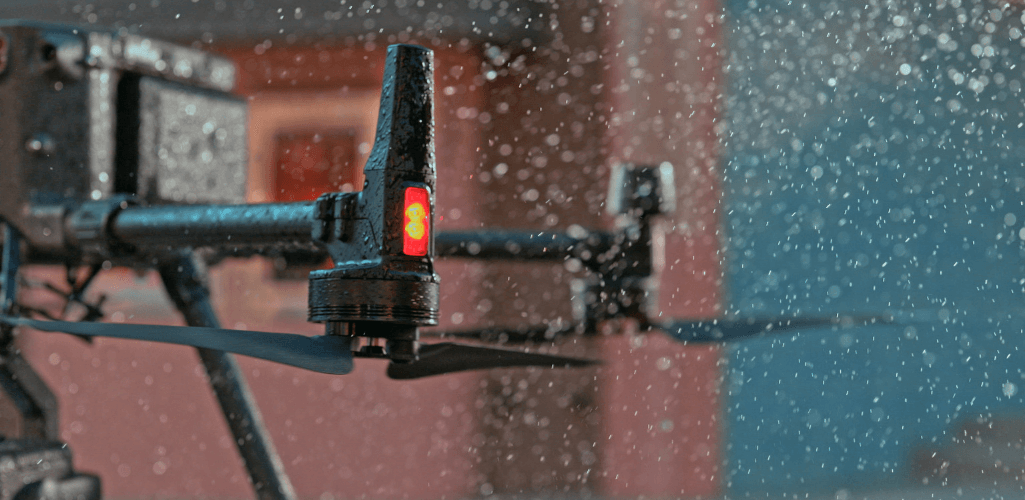
UK Drone Laws: Drones And Privacy
When you are flying, ensure that you do not invade anyone’s privacy, especially if your drone has a camera.
The UK Information Commissioners Office (ICO) recommends that users of drones with cameras should operate them in a responsible way to respect the privacy of others.
If your drone or model aircraft has a camera, any photos or video you take may be covered by the General Data Protection Regulation (GDPR).
If you take a video or photo of someone where they can expect privacy, such as inside their home or garden, you’re likely to be breaking data protection laws.
Some tips include:
Let people know before you start recording: If you are capturing an image or footage of friends or family, this will be easy. But in some cases, this won’t always be possible, so be sensible and apply common sense before you start.
Know your camera: Get to grips with your camera, because knowing its capabilities will help reduce the risk of privacy invasion. Some key questions include, what is the quality of the image? How powerful is the zoom? If you can start/stop recording when you’re flying.
Make sure you can be seen: The more visible you are then the easier it will be for other people to identify who is flying the drone.
Think before sharing: Be mindful of what images/videos you have captured and if the content is sensitive, unfair or harmful before you share them on social media or post on a website.
Keep the images and video safe: Store your content in a safe place and delete what you don’t need.

written by
James Willoughby
James joined heliguy™ in 2018 following a 13-year stint in print and online journalism, having worked on regional and weekly newspaper titles. He is responsible for spearheading heliguy™'s content strategy and social media delivery. James collaborates with DJI Enterprise's European marketing team to coordinate and produce case studies and helps organise events and webinars.